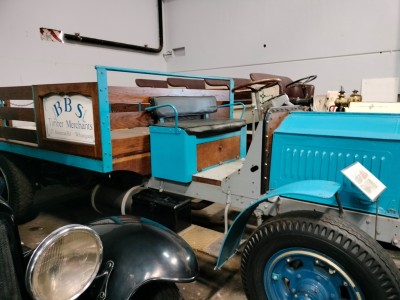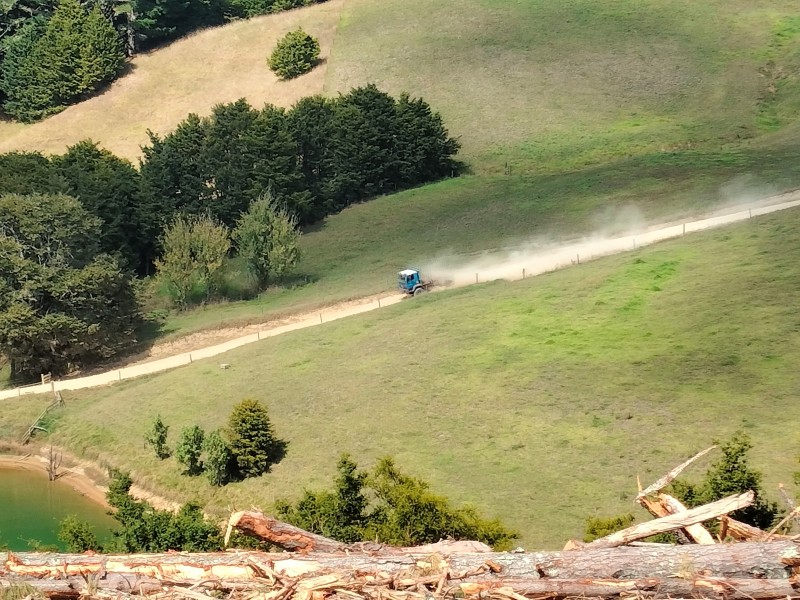Northland Farm Forestry Newsletter – July 2025
Editorial – Increase your Farm Profitability? Yes please!
Farmers, we need you. As growers of meat, milk and wool, you supply NZ and the world with some of the best produce on the planet… and we want you to stay in the game.
This may be a no-brainer for many of you because your business is humming. But recent whole farm conversions to forestry attest that farms at the marginal end of the spectrum are, well… marginal. So, thinking about it – if forestry is profitable on your marginal farm areas, why don’t you do a little bit of forestry for yourself?
If you’re like me, you might have approached the whole ETS thing years ago with a degree of suspicion, or perhaps even cynicism. Well, ETS is here and it’s working. On marginal land, it will exceed beef and lamb for returns per hectare. To be fair Beef + Lamb NZ know this and support mixed-use farming. And why shouldn’t they? Because it’s one way you can stay in the game. As farm foresters, we are on the same page as Beef + Lamb on this (although I like to think that they’re on our page :).
If I said you could double your net per hectare return off that rough-as-guts back paddock, you’d listen, right? Well afforestation will do that and more. You don’t even have to lock it up in perpetuity, as you will receive 16 years’ worth of ETS return even if you harvest the trees. You do have to replant after harvest though. With ETS, you can even start seeing significant returns well before you harvest. Maybe this will help with succession planning? Anything to get the kids to look positively at your farming business has got to be good, right?
The recent rule changes around whole farm conversions will still let you plant a proportion of your own property. To clarify, any tree species, native or exotic, that reaches 5m at maturity would qualify for ETS.
For non-Pinus radiata regimes, you may be in the fortunate position where you could be part funded for the pasture retirement and establishment of afforestation. Talk to Northland Regional Council (natives and Poplars only), or Kaipara Moana Remediation (pretty much everything except P. radiata). If the land is considered at risk of erosion, you may qualify for some funding.
This is too big a topic to cover here, and there are some important factors you need to be aware of, so please reach out to Beef + Lamb or Te Uru Rakau to get the best advice. There will no doubt be some Dairy support blocks that would benefit from some mixed-use afforestation, so you folk can talk to your Fonterra SDA.
So, before you think about closing the gate for good, please reach out and ask what ETS could do for your business. We all know that farming is much more than a business, but it has to be profitable. And it will be. You just have to decide how.
Northland Farm Forestry Field Day – Clunie Sawmill & Packard Museum, June 2024 - Angela Taitoko
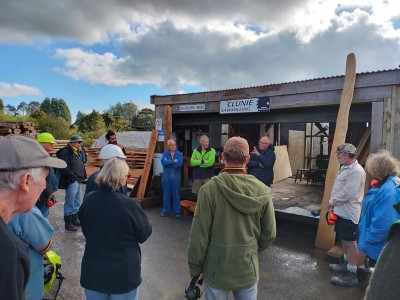
Located in the heart of Maungatapere and situated down the back of the Packard Museum, the advertised field trip to Clunie Sawmill coaxed a strong number of members out on a fine winter’s day. Our host Dennis Clunie was relieved that his promise to Angela Taitoko – the organiser – to deliver a sunny day, was upheld for the entire 2 hour visit.
Angela approached Dennis and asked if there was a possibility that our members could have the opportunity to see his sawmill , yard and timber. This was driven from conversations at earlier field days where we as a group were keen to interact with industry that take the humble cedar, poplar, eucalypt or redwood and macrocarpa etc and mill and dress it for the end user. So we really were in for a treat as not only did Dennis agree but even offered to give us a demonstration of his two mills in operation. Clearly an opportunity too good to pass up and we all eagerly awaited the tour to commence.
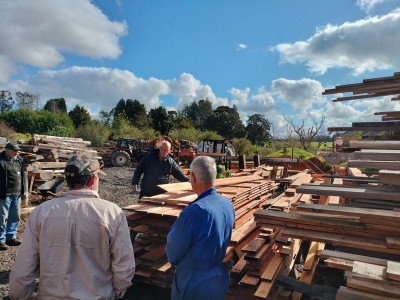
Northland, a region known for its rich natural resources and extensive forests, and Maungatapere alike are known for their historical significance and contributions to the local timber industry. The sawmills over the years have been an important part of the region's economic and social landscape. Millers like Clunies have historically played a crucial role in the development of these areas, providing materials for construction and other industries, as well as employment opportunities for local communities.
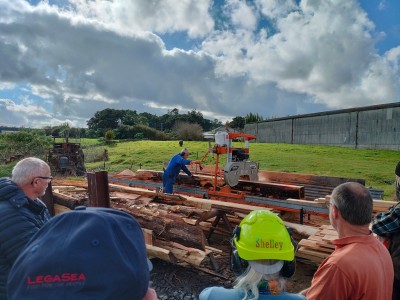
The history and operations of Clunie Sawmill might also reflect broader trends in the timber industry in New Zealand, including changes in technology, changes in forest management practices, and shifts in market demand for timber products. Sawmills often evolve over time, incorporating new machinery and techniques to increase efficiency and reduce environmental impact.
Clunie Sawmill in Maungatapere continues to be active and serve the Whangarei region. Established in 2005, the sawmill, whilst only occupying a relatively small yard, specializes in providing high-quality timber products, including Macrocarpa, Japanese Cedar, Poplar, and Redwood. They cater to a variety of customers such as builders, homeowners, retailers, gardeners, landscapers, and schools, and man/she cave groups offering services like timber sales and contract milling.
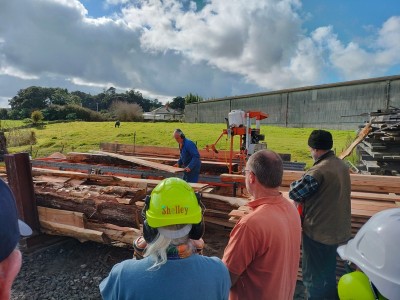
It was apparent during our discussions that Clunie Sawmill prides itself for its ability to cut timber to order, providing materials for landscaping, construction, renovations producing products like timber panelling, sleepers for raised garden beds, exposed beams, bar learners and slabs for bench tops and shelving. Dennis emphasized and draws from his experience and guidance from other local timber enthusiasts, ensuring that timber is cut and handled to meet exact specifications.
Having started out on a Lucas Swing Blade Mill back in 2005 Dennis produced macrocarpa sleepers and over time worked with Japanese cedar and luscitanica, amongst other species.
Over the years Dennis has learned that an ‘ugly’ log can be better to work with, having travelled the region and taking his portable setup to the logs. In 2018 it was time for Dennis to set up the mills and have the logs brought to him. Dennis has now been using this approach since, and finds he can build his network of customers and bring the logs to the permanent set up that has found a home in Maungatapere.

The Clunie sawmill is a Monday to Friday operation and employs two additional workers to get through the orders, but they are spared the effort of dealing with the waste. When questioned about the waste products of tailings and sawdust Dennis explained that he had established a good working relationship with a local outfit who were able to collect and transport the waste during the weekend to use in local gardens .
Clearly from Dennis’ willingness to take questions from our members, he has learnt a thing or two over the years. He was very forthcoming in answering a vast array of questions regarding local market for eucalyptus, poplar and Tasmanian blackwoods from his perspective. Dennis has come to prefer certain species over others and the ‘shelf life’ of logs is important too. Following the Q&A session and listening to an extensive health and safety briefing pertinent to sawmill safety and ‘safe zones’ we got up close (but not too close!) to the Norwood Lumbermate LM29 Band Saw and the Mahoe Mini Max.
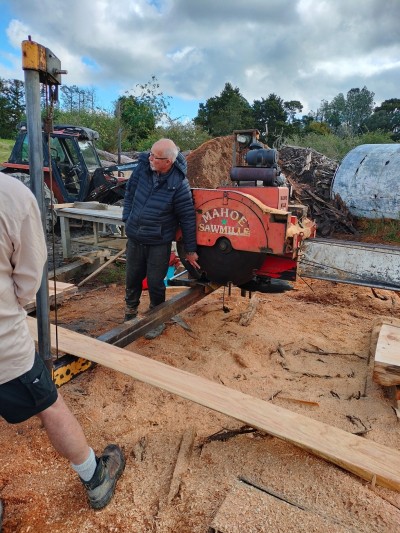
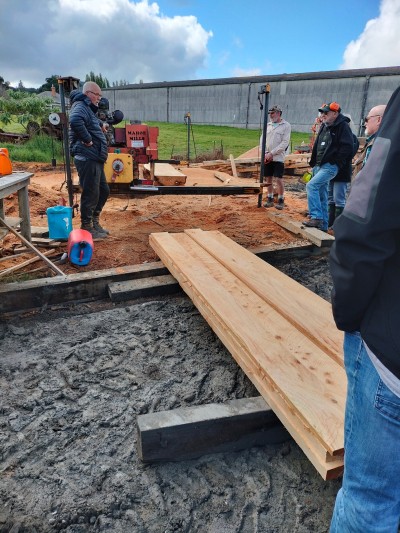
Concluding the impressive demonstration and having gained insight and answers we set off for our picnic lunch and tour of the Packard Museum.
The Packard Museum was conveniently situated right next door to the Sawmill in the old Maungatapere Dairy factory, its origins as the name suggests began dedicated to the classic Packard automobiles. The museum showcases a collection of vintage Packard cars, which were known for their luxury and engineering excellence during their heyday.
However, the museum has since evolved and expanded to also include an enticing array of Allis Chalmers tractors and bulldozers and International Trucks . What was a surprise to the members that stayed on to take the tour was that the collection had been extensively added to and occupied all the 5 buildings on the Maungatapere site, including many vintage heavy forestry and roading machinery parked outside. Of particular interest to the members was Shed 2 which was where it was all at, for a hard core group of 6 members. The Big Back Shed jammed full of trucks, bulldozers and tractors was probably where we lingered the longest, such to the point that a search party was needed to bring the group back together before we parted ways after such an informative and memory evoking day.
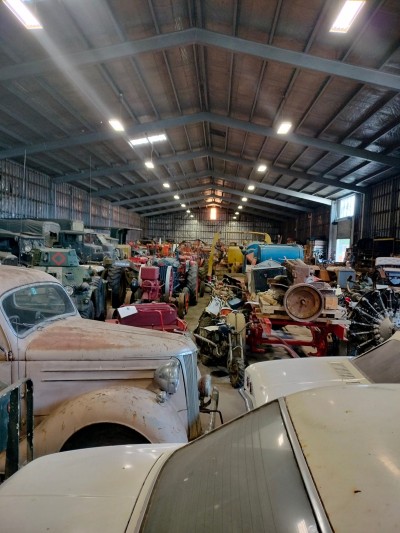
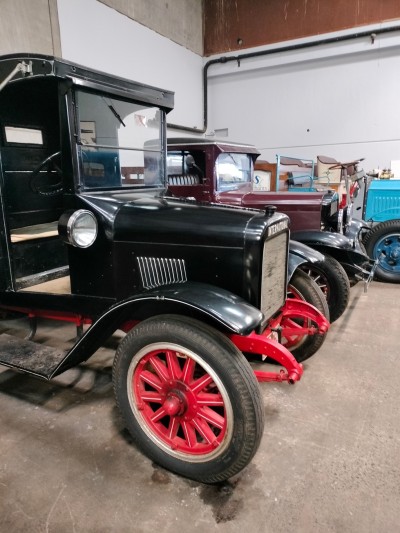
For more information or to get in touch with Clunie Sawmill, you can visit their official website or contact them directly at 021 791 457 or cluniesawmilling@gmail.com or find them on Facebook Marketplace https://www.facebook.com/marketplace/item/8632971306717460
For details for making your own way to Packard Museum check out their website www.packardmuseum.co.nz . The Packard Motor Museum is open Wednesday, Thursday, Friday and Saturday 10am– 4pm. You can contact them by telephone on 09 434 8214 or by Email info@packardmotormuseum.co.nz or message them on Facebook at Packard Museum.

